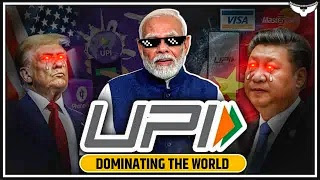How UPI Revolutionized Digital Payments in India: Impact on Visa, Mastercard, and Global Finance
 |
| How UPI Revolutionized Digital Payments in India |
India's UPI: The Revolutionary Technology Shaking Up the Financial World
Unified Payments Interface (UPI) has become a groundbreaking technological innovation since India's independence. It's not just changing the way financial transactions happen in India but is also shaking up global financial systems, causing unease among giants like Visa and Mastercard. In this article, we’ll dive into what UPI is, why it was created, how it works, and why even the United States is concerned about its rise.
What is UPI and Why Was it Created?
UPI is a real-time payment system developed by the National Payments Corporation of India (NPCI), launched in 2016 under the visionary leadership of Raghuram Rajan and Dilip Asbe. It was designed as an upgrade to existing payment systems like RTGS, NEFT, and IMPS, offering unique features that make it a game-changer in the world of digital payments.
Here’s how UPI addresses the limitations of earlier systems:
1. RTGS (Real-Time Gross Settlement): Suitable for transactions above ₹2 lakhs but not for smaller amounts.
2. NEFT (National Electronic Funds Transfer): Allowed smaller transactions but processed them in batches, causing delays.
3. IMPS (Immediate Payment Service): Enabled instant transactions for amounts below ₹2 lakhs but had limitations for merchant payments and required the addition of beneficiaries, adding to the time and complexity.
UPI bridged all these gaps by introducing:
A Virtual Payment Address (VPA): No need to share bank details.
Interoperability: Seamless transactions across payment platforms like PhonePe, Google Pay, and Paytm.
24/7 Service: Transactions can be done instantly, any time of the day, without any charges.
The Meteoric Rise of UPI
UPI started slow but received a significant boost with some key events:
1. Demonetization (2016): The sudden ban on high-value currency notes forced people to adopt digital payments.
2. Affordable Internet: The launch of Jio revolutionized internet access in India, enabling even rural users to join the digital economy.
3. Private Sector Involvement: Companies like PhonePe, Google Pay, and Paytm promoted UPI, making it popular across demographics.
By 2022, UPI became the world's largest real-time payment system, processing over 100 billion transactions monthly, with a gross market value exceeding ₹10 lakh crores. Its simplicity, speed, and zero-cost model made it a favorite for both consumers and merchants.
Why is the US Worried?
The United States has long dominated the global financial ecosystem with its dollar supremacy and technologies like SWIFT for international payments. However, UPI's emergence has posed a challenge to this dominance. India’s NPCI has launched NPCI International Payments Limited (NIPL) to promote UPI globally. Countries like Bhutan, Singapore, UAE, and France have already adopted it, and more nations, especially in Asia, are showing interest.
The US and Europe may resist UPI's entry, but the growing adoption across Asia and even Europe could gradually weaken the dominance of traditional financial systems.
Impact on Visa and Mastercard
Visa and Mastercard, global leaders in payment networks, charge merchants a fee known as Merchant Discount Rate (MDR)—typically 1-3% per transaction. UPI, on the other hand, operates at zero MDR, allowing merchants to accept payments without additional costs. This has led to a significant decline in card transactions in India, with merchants actively promoting UPI over card payments.
Moreover, UPI's interoperability means customers can pay across different apps and platforms, further reducing the reliance on traditional card networks.
Future of UPI: Upcoming Features
UPI is not stopping here. RBI has announced new features to make it even more powerful:
1. Linking with Credit Cards: Currently, UPI is linked only to debit cards, but soon, it will support credit card transactions, expanding its usability.
2. UPI Lite: A feature for offline payments without internet access, enabling small transactions in areas with poor connectivity.
3. UPI 123PAY: Designed for people without smartphones, this feature allows payments through simple phone calls.
These innovations aim to make digital payments accessible to every Indian, including those in rural and remote areas.
Why UPI is an Environmental Win
UPI not only saves time and costs but also reduces the need for physical currency. Printing, maintaining, and replacing currency notes is expensive and resource-intensive. With UPI, these costs are minimized, benefiting both the economy and the environment.
Conclusion
India’s UPI has become a symbol of technological and financial innovation, putting the country at the forefront of the global digital payments revolution. As more countries adopt UPI, its impact will continue to grow, challenging traditional systems and reshaping the global financial landscape.
UPI’s story is a testament to how a developing country can lead the way in innovation and set benchmarks for the world to follow. It’s not just a payment system; it’s a revolution.
Tags
Cashless Economy
Digital India
Digital Payments
Fintech India
Future of Payments
NPCI Innovation
UPI 123
UPI Autopay
UPI Features
UPI Global Impact
UPI Growth
UPI Revolution
UPI vs Visa